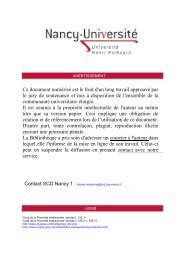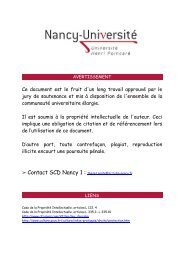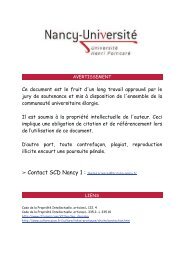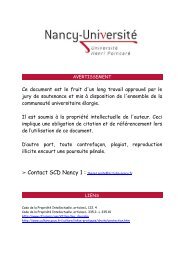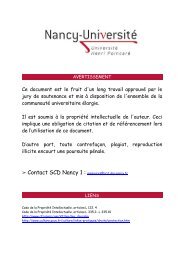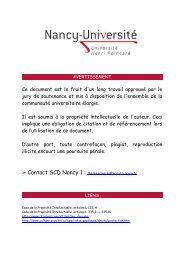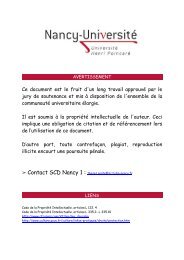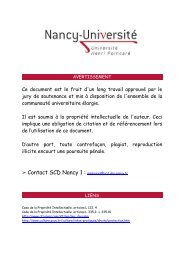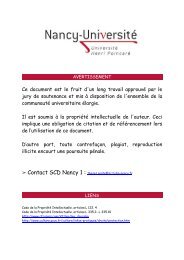Ce document numérisé est le fruit d'un long travail approuvé par le ...
Ce document numérisé est le fruit d'un long travail approuvé par le ...
Ce document numérisé est le fruit d'un long travail approuvé par le ...
You also want an ePaper? Increase the reach of your titles
YUMPU automatically turns print PDFs into web optimized ePapers that Google loves.
Peroxisome proliferator-activated receptors are key regulators in cell differentiation<br />
149<br />
• Fibrates,.NSAIDs<br />
@ PGJ2 1<br />
.phosphorylation<br />
RXR<br />
Figure 1 : Activation ofppARs<br />
(1). Extracellular ligands cross the p1asmic membrane and they bind to PPAR (1). Ligand binding<br />
follows phosphory1ation (~:)or dephosphory1ation of receptor (2). Severa1 ligands, NSAIDs for<br />
instance (e), have been shown to inhibit ppAR transcription by direct interaction with activated<br />
receptor into the nuc<strong>le</strong>us. Prostag1andin J2 derivative .) has a1so been shown to alter activation of<br />
NFKl3 (3) by inhibiting phosphory1ation of IKl3 via IKl3 kinase. ppAR ligands cou1d a1so be<br />
synthesize within the cell via the cyclooxygenase (@) or the 1ipoxygenase (0)pathway from<br />
arachidonic or 1ino1eic acid (4,0 ). Finally ppAR form an heterodimer with RXR which bind to<br />
PPRE on promotor of target genes (5). Subsequent1y, they increase or si<strong>le</strong>nce gene transcription<br />
1eve1 by interacting with cofactors or corepressors. (abreviations : NSAID : nonsteroida1 anti<br />
inflammatory drug; PGJ2 : 15-deoxy-ô-12, 14 prostag1andin J2; RXR, 9-cis retinoic acid receptor)<br />
AGGTCAnnnTGACCT [17]. In addtion,<br />
RXR as well as ppAR interact with the<br />
thyroid hormone receptor sugg<strong>est</strong>ing that<br />
crossta1k may exist between ppAR, RXR and<br />
thyroid hormone receptor [18, 19]. Formation<br />
of the heterodimer and subsequent<br />
transcriptiona1 activation are 1iganddependent.<br />
Ligand binding induces a<br />
conformation change which places the<br />
COOH-terminal helix 12 of the 1igand-binding<br />
domain adjacent to a hydrophobic c1eft on the<br />
surface of the 1igand-binding domain. This<br />
occurs through direct protein interactions<br />
with the LXXLL motif present in the<br />
coactivator protein [20]. This modification<br />
allows the binding of coactivators on the AF-2<br />
domain 10ca1ised at the COOH-terminal ofthe<br />
ligand-binding domain. As for other nuc1ear<br />
receptors, coactivators consist of two genera1<br />
classes [20, 21]: One class includes the steroid<br />
receptor activator-1 family of proteins with<br />
histone acetyltransferase activity which



